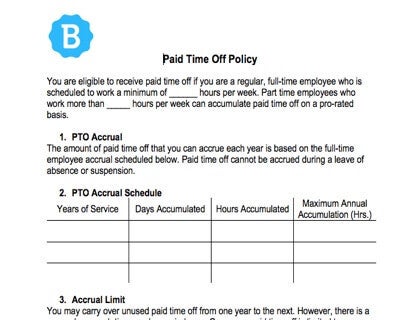
Paid Time Off Policy Sample Download:
Download our free Paid Time Off Policy template in Microsoft Word format.
Download NowPaid Time Off Policy Sample:
Paid Time Off Policy
You are eligible to receive paid time off if you are a regular, full-time employee who is scheduled to work a minimum of __ hours per week. Part-time employees who work more than _____ hours per week can accumulate paid time off on a pro-rated basis.
- PTO Accrual The amount of paid time off that you can accrue each year is based on the full-time employee accrual schedule below. Paid time off cannot be accrued during a leave of absence or suspension.
- PTO Accrual Schedule
Years of Service | Days Accrued | Hours Accrued | Max.Annual Accrual ____ ____ ____ ____ ____ ____ ____ ____ ____ ____ ____ ______
- Accrual Limit You may carry over unused paid time off from one year to the next. However, there is a cap on how much time can be carried over. Carryover paid time off is limited to _____ times your annual paid time off limit.
- Termination In the event that your employment is terminated for any reason, you will be paid for any unused paid time off.
- Managing Paid Time Off It is your responsibility to manage your paid time off and plan for it in advance. This means that you should consider when you will take a vacation or take days off for personal business. Remember, it is in your best interest to keep some days in reserve in case of unexpected events.
- Minimum PTO Increments The smallest increment of paid time off that you can take is [hour, half day, one day].
- Notice All employees must provide their respective supervisors with reasonable notice of their intention to take time off and must have their request formally approved for scheduling purposes. Emergency circumstances may make advanced notice impossible. In the event of illness or emergency, speak to your supervisor as soon as possible.
- Records It is your responsibility to complete an absence report for any paid time off that you use. We are required to track all absences for legal and compliance purposes. These reports will also be used to record your remaining amount of paid time off on your pay stub.
How to Implement a Paid Time Off Policy:
1. Determine your PTO structure.
If you're running a new small business, no doubt you're thinking about employee benefits, salaries, and other incentives. An important part of employment is a fair amount of vacation time. As a business owner, you need to determine how much time off you are willing to give your employees each year. You also need to decide how much extra paid time off you will reward employees who are loyal to your company. Usually, this involves creating different tiers for years of service.
2. Put your paid time off policy in writing.
Once you have determined how much paid time off will be allotted, write down the time with the corresponding years of service. At this stage, you will also want to consider what other paid time off procedures you want to use, particularly for reporting and tracking paid time off. In most businesses, employees must give their supervisor or manager advanced notice before taking paid time off. You should specify this in your PTO policy and outline how you would like your employees to record their vacation days. You can use a company-wide online calendar to keep track of who is on vacation so that everyone has access to it. You should also have your managers keep a spreadsheet with PTO information for each employee so that no one exceeds their limit in a given year.
Unlimited Vacation Policy:
An unlimited vacation policy places no time limits on the amount of vacation that employees can take each year. With an unlimited policy, there is no time accrued from one year to the next.
3. Formalize your policy and share it with your employees.
Finish drafting your paid time off policy and make sure everyone in your organization receives a copy of the document. If you are on-boarding several new employees at once, it may be useful to walk them through the policy and answer any questions that they might have about it. You paid time off policy can be included in your employee handbook.
4. Refine and edit as necessary.
Nothing is ever perfect. If you need to update your original PTO policy to make improvements or account for changes in your business, edit the policy and notify your entire team that changes have been made.
Final Thoughts.
Clearly articulated company policies can help you to manage your workforce and avoid difficult confrontations in the workplace. If you have a paid time off policy to refer to, it's easy to create a procedure for taking time off. More importantly, a paid time off policy helps your employees to understand what your expectations are when they do take time off.
When you are in the process of hiring new employees, a paid time off policy is the best way to answer their vacation questions. When a job offer is extended to a successful applicant, your vacation accrual policy is probably one of the first things that they will look at.
A paid time off policy is just one of the policies that your small business needs. For more information about other policies and for free samples, check out our attendance policy, dress code policy and company vehicle policy.
Similar Policies:
- Bereavement Leave Policy.
- Cell Phone Policy.
- Company Credit Card Policy.
- Company Travel Policy.
- Company Vehicle Policy.
- Conflict of Interest Policy.
- Cyber Security Policy.
- Dress Code Policy.
- Paid Time Off Policy.
- Social Media Policy.
- Telecommuting Policy.
- Overtime Policy.
- Attendance Policy.
- Expense Reimbursement Policy.
- Sexual Harassment Policy.
- Remote Work Policy.
- Substance Abuse Policy.

